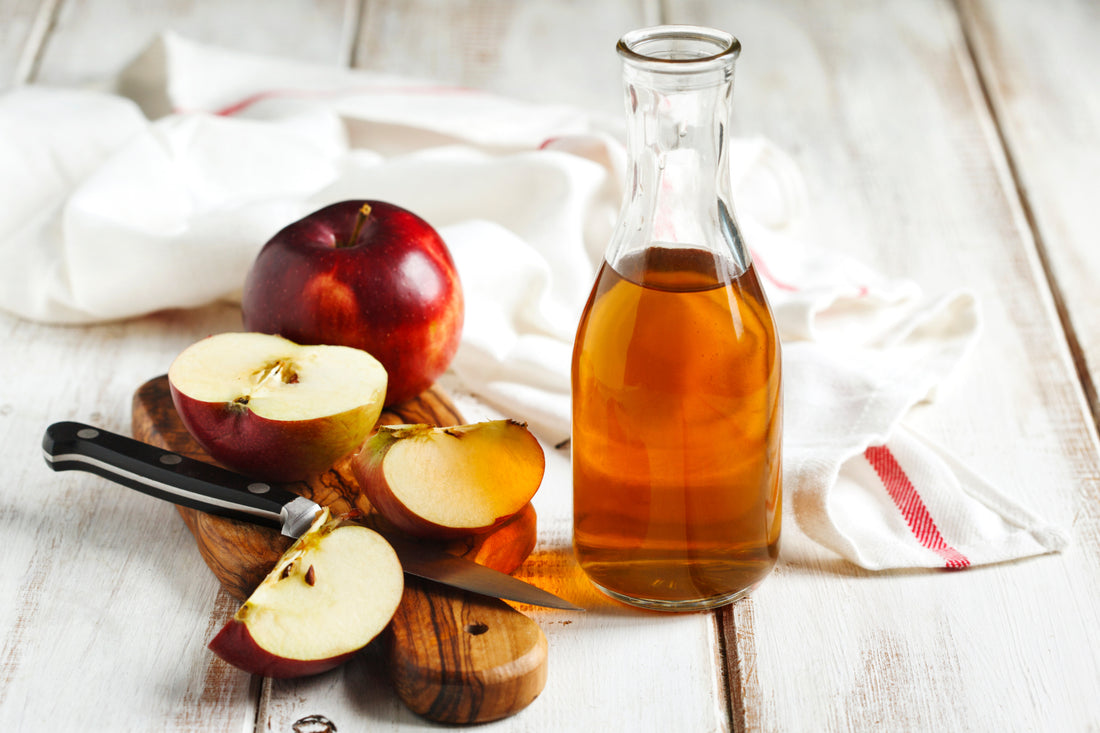
How To Make Soap With Apple Cider Vinegar
Andrea MarahShare
If you've ever tried to make an apple cider vinegar soap the usual way you make soap, it may have been a soft mess. Let me tell you why.
Sodium hydroxide is a strong alkaline substance while ACV is a weak acid. Therefore, chemically, the acid content of the ACV is neutralizing a portion of your lye solution and lowering its pH. This means there is less lye to bond to the oils during saponification due to a now higher superfat content. So, you have to account for this when calculating your recipe and do bit of extra math. If you do not add the extra lye, it may result in softer bar with reduced lather.
The Math
For every ounce of apple cider vinegar that is added to the recipe, you will add an additional gram of sodium hydroxide. The final bar may still be a bit soft, but it will continue to harden as the soap cures.
For example, if you are adding five ounces (by weight) of apple cider vinegar, you add an additional five grams of sodium hydroxide to the total lye amount.
How I Formulate With Liquid Ingredients
When creating a soap with a liquid ingredient, that liquid is usually used to replace the distilled water in the recipe. While this is common practice among most soap makers, my personal preference is to use at least a 1:1 amount of lye to distilled water and replace the additional water over that amount with my liquid of choice.
CAUTION: Before trying this, become familiar with the safe lye handling and good manufacturing practices to be as safe a possible. Lye is a caustic substance that can and will cause severe burns if handled improperly. Be sure to work in a clean and ventilated area free of children, pets, and distractions. Have all of your materials, equipment, and ingredients gathered together before you begin.
Rosemary Lavender Facial Soap Recipe (yields about six 5-ounce bars):
All measurements are by weight, not volume.
Oils & Butters
- 8 ounces olive oil
- 5 ounces coconut oil
- 5 ounces palm
- 1 ounce shea butter
- 1 ounce castor oil
Lye Solution
- 3.30 ounces distilled water
- 2.80 ounces sodium hydroxide (lye)
- 3 grams sodium hydroxide (lye)
- 3 ounces apple cider vinegar
Additives
- 0.30 ounces rosemary essential oil
- 0.30 ounces lavender essential oil
- 1 teaspoon French green clay
- OPTIONAL: lavender buds and rosemary leaves
Materials & Equipment
*Make sure your mixing equipment is heat resistant.
- an accurate kitchen scale
- infrared thermometer
- gloves (rubber or nitrile)
- safety goggles
- apron
- mask
- stick blender
- 6-cavity round soap mold
- large stainless steel pot, plastic, or glass bowl*
- several measuring cups or small containers
- stainless steel spoon
- silicone spatula
- plastic or glass pitcher* with lid
Mixing The Lye
CAUTION: Lye is a caustic substance that can and will cause severe burns if handled improperly. When mixed with water, the solution can exceed 200°F and produce fumes. Be sure to work in a clean and ventilated area free of children, pets, and distractions. Have all of your materials, equipment, and ingredients gathered together before you begin.
Making the lye solution is by far the most difficult (and stressful) part of the soap making process. Be sure to measure accurately and carefully. Before beginning, turn on the scale and make sure it is measuring ounces.
- Suit up. Tie back any loose hair. Put on your apron, gloves, mask and goggles.
- Place a measuring cup on the scale and tare the scale to zero the weight.
- Weigh out the distilled water and pour into the pitcher.
- Repeat step 2 for another container or cup. Carefully open your lye and weigh out both amounts of lye into the container. Immediately close the lye and set aside.
- Take the pitcher of water and slowly add the lye into the distilled water (DO NOT pour water into the lye). Avoid splashing and breathing in the fumes. I prefer to run a fan during this step but you can also work near an open window.
- Without splashing, slowly stir the lye and water with your spoon. It will get VERY hot and cloudy and may produce steam or bubbles. Continue gently stirring until the lye is dissolved and mixture goes clear.
- Weigh, pour, and mix the ACV into the lye container without splashing.
- Rinse your spoon. Use the lid to cover the lye solution and set it aside on a stable surface. We will use it once it cools to between 100-110°F.
- You can now remove your mask.
NOTE: I like to change my gloves or wash my gloved hands after this step in case there is any lye dust on my hands.
Making The Soap
- Prep your mold and set aside.
- Hydrate your clay with 1 tablespoon of distilled water. Set aside.
- Place a measuring cup on the scale and tare the scale to zero the weight.
- Melt (if necessary) and weigh out each oil one-by-one on the scale into a container or cup.
- As they are weighed pour them into the large pot or mixing bowl. Scrape your containers well.
- Measure your fragrance into another container and set aside.
- If using a pot, place on the stove on LOW and gently heat the oils to about 100-110°F. If using a heat-safe bowl, place your container into the microwave and gently heat to between 100-110°F. Check frequently so your oils do not get too hot.
- Check your lye temperature. When both oils and lye are between 100-110°F, slowly pour the lye solution into the melted oils.
- Using short blasts from the stick blender, begin stirring.
- Continue mixing until your reach "thin trace", also called "light trace". Thin trace is when the oils and lye solution are blended and there are no oily spots left in the mixture. It should resemble a thin batter.
- Add your green clay slurry.
- Add your essential oils and stir your batter until the oils and clay are completely blended.
- Carefully pour your soap batter into each cavity of the soap mold. Divide as evenly as possible. Very gently tap the mold against the surface of the table.
- Decorate the tops of the soaps with your lavender buds and rosemary leaves if desired.
- Place your molded soap on a level surface for 24-48 hours to cool and harden.
- Unmold your soap.
- After the soap cures and dries about 4-6 weeks it will be ready to use.
